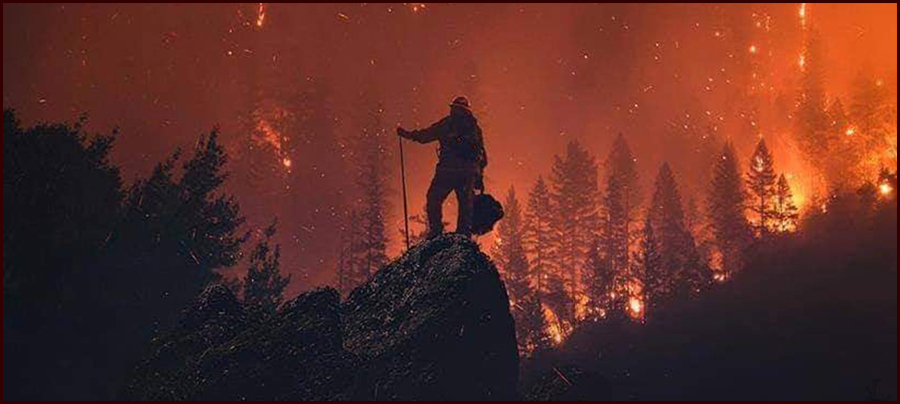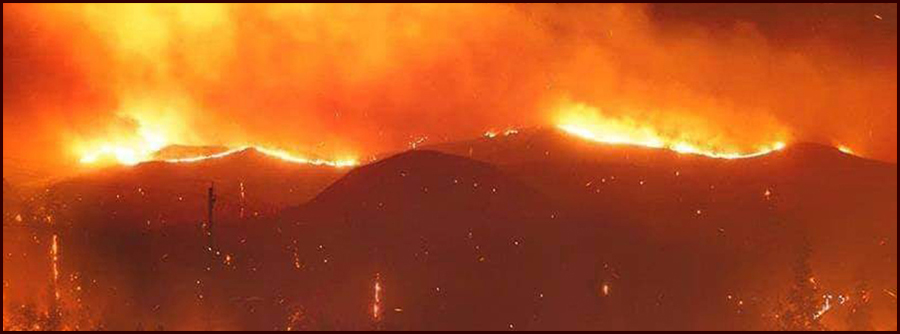Holy Smoke Words & Music by Doug Johnson
Doug Johnson has been a regular attendee of our Big Sur Songwriting workshops since the first one in 2005. Doug’s songs are always greatly appreciated for his insights and comfortable humor. But he also has a unique and engaging finger picking guitar style, very rhythmic and innovative which helps to keep the listener in an attentive trance.
In his song, Doug writes about the territory of the Kumeyaay people in the region near the harbor which Juan Rodriguez Cabrillo found in 1542, and named for Saint James or ‘San Diego.’ Borrego Springs, the Mountain of the Sleeping Indian and Hell Hole Canyon are near Julian, California where Doug lived for many years. He fought two fires that threatened his home, one from his front porch.
The Kumeyaay, also known as Tipai-Ipai, are a tribe of Indigenous peoples of the Americas who live at the northern border of Baja California in Mexico and the southern border of California in the United States. It is believed that they have occupied the region for 12,000 years. Their Kumeyaay language belongs to the Yuman–Cochimí language family.
The song is about wild fires, and since the fires in California this year have been horrendous, we have purposely held off writing about this song until it seemed that the danger had diminished. Sadly, these days the fire season is not just restricted to the late summer and fall of former times.
Climate change has affected the cycles of rainfall and warmer temperatures have exacerbated the conditions that cause massive fires. Five of the twenty largest wildfires in California history occurred in the 2020 wildfire season.
Park Williams, a bioclimatologist at Columbia University said in a New York Times interview, “While California’s climate has always been fire prone, the link between climate change and bigger fires is inextricable. This climate-change connection is straightforward: warmer temperatures dry out fuels. In areas with abundant and very dry fuels, all you need is a spark.”
In the journal of Advanced Earth and Space Science, researchers concluded that: “Human-caused warming has already significantly enhanced wildfire activity in California, particularly in the forests of the Sierra Nevada and North Coast, and will likely continue to do so in the coming decades.”
Many have observed that fire is a natural occurrence in the forest and has many beneficial effects. Native people lived with the cycle of fire and renewal in a way that today’s residents of the forested areas cannot.
Some have commented that the problems of fire control have been intensified by the inadequate clearing of underbrush. The issue is not simple, and relaxing regulations to allow for more logging is not the answer.
Fire is a fearsome thing, but natural and inevitable. Being able to flee has always been the important thing. The native peoples didn’t have pickup trucks. They did have the rituals and the wisdom to respect the power of lightening and spontaneous combustion.
And they had strategies of intentional burning, and even used fire in forms of hunting, but none of that is relevant to the contemporary builders of what they hope will be permanent homes in the woods.
In an excellent article for The Guardian called "Fire Is Medicine", Susie Cagle wrote of the traditional practice of burning California forests to renew them. “This fire will chew out the underbrush and lick the moss off the trees. It will blister the hazel stalks and coax strong new shoots that will be gathered and woven into baskets for babies and caps for traditional dancers, and it will tease the tan oak acorns to drop. It will burn the invasive plants that suck up the rain, letting more clean, cool water flow through the black, into the watershed and down the Klamath river for the salmon.
“Soon all that black will be dotted with bear grass and huckleberries pushing up for the sunlight and down for the water they couldn’t reach when they were crowded out by tall scotch broom and dense twists of blackberries and the ever-encroaching fir trees. Even sooner, animals will flock here to roll in the ash, a California dust bath.
“For more than 13,000 years, the Yurok, Karuk, Hupa, Miwok, Chumash and hundreds of other tribes across California and the world used small intentional burns to renew local food, medicinal and cultural resources, create habitat for animals, and reduce the risk of larger, more dangerous wild fires.
“After suppressing fire in all forms, and the traditional ecological knowledge that went along with it, California’s top politicians and fire officials are now seeking out tribal guidance on fire policy as state agencies gear up to burn more than ever before. The state’s air quality managers are tasked with outreach to educate the public on the benefits of fire, as regions hand out more and more burn permits. In one particularly busy month in 2018, the north coast air quality management district permitted over 250 prescribed fires in the region.”
In addition to climate change, Southern California has always had the Santa Ana winds that Doug writes about. Each fall, strong gusts bring dry air from the Great Basin area of the West, up over the mountains where they lose any moisture and down into the coastal areas. It’s not just that the Santa Ana winds dry out vegetation; they also transport the embers, spreading the fires.
In Raymond Chandler's story Red Wind, he calls upon "those hot dry winds that come down through the mountain passes and curl your hair and make your nerves jump and your skin itch. On nights like that every booze party ends in a fight. Meek little wives feel the edge of the carving knife and study their husbands' necks. Anything can happen."
As kids growing up in Southern California we were aware of these effects. We thought of the wind as a witch, but have since explored the idea of the effect of negative ionization on mood – a little less superstitious approach.
Doug shared a few thoughts about how he came to write “Holy Smoke.”
“From a lookout just east of Santa Ysabel, perched above the San Diego Valley, two Kumeyaay Mission Indians climbed up behind us, for a view of the flames approaching below. “Holy smokes!,” the one said and so was born the title to my not yet written song.
“For two years, that spark incubating in my brain, and every fire season it was smoldering toward the surface.
“I was jamming with a friend, and he left my guitar in a “D-A-D-G-A-D” tuning, which was Greek to me. In the morning, I started pecking out notes, blindly putting chords together and so was born the melody. I’m not sure how but it started coagulating the song which just blew through an open window, I suppose.
“I’ve found my best songs are the ones harmonious with the heart. My muse is best infused with love, family and occasionally adversity, to keep it all level.
“So, I ran it up the flagpole at the next Big Sur Workshop and was encouraged to put it on a sampler CD. Later, Steve and Cindy picked it up, made a few necessary changes and put a professional edge on it!
“To be part of their songwriters workshop, especially the input from peers, has been a blessing. I can’t keep up with most of the technical side, (hey-I’m just a three cord guy). The camaraderie, for me, is always most important!
“Our latest CD is called A Page From Sixty-three. If someone wants one they can contact us at: joananddoug@sbcglobal.net.”
Here is a video that our friend Tim McMullen captured of Doug performing his song for the group of us at the 2012 gathering of the Big Sur Songwriting Workshop held in Santa Cruz. Tim is our official videographer and archivist for the workshops. You can hear the voices of the supportive crowd of Doug’s fans.
Doug Johnson performs his song "Holy Smoke"
Video by Tim McMullen
And here is a another of Tim’s videos capturing a performance of Doug’s song by Cindy and me for the group at our 2015 workshop.
Steve & Cindy perform Doug Johnson's "Holy Smoke"
Video by Tim McMullen
Our version of the song is on on our Compass Rose CD, Home By Dark.
Here are the lyrics:
You can feel the tension and the fear
Grandma's chickens are acting queer
Here we go again
Could be a branch on a high wire catches
Careless kids playing with matches
Dry grass where the lightning flashes
Here we go again
There’s a devil in the Santa Ana winds
From the mountain of the Sleeping Indian
Grandma calls for Kicking Goat
She comes on the run, tears her coat
Upon the limbs of a creosote
Here we go again
They all pile into a pickup bed
With a rolled-up rug and the Rhode Island Reds
Adrenalin drummin' and someone says
Here we go again
There's a devil in the Santa Ana winds
From the mountain of the Sleeping Indian
The Great Ghost is galloping across the nation of the Kumeyaay
He's ridin' on a crimson stallion through a smoky obsidian sky
From Witch Creek to Borrego he's blotting out the sun
In Hell Hole Canyon the bighorn Sheep don't know which way to run
They don't know which way to run
Safe in the desert ‘round Yaqui Wells
An old woman fans an abalone shell
That smudging sage and a prayer might heal
Here we go again
Far to the West, conjured clouds
Bring the rain in sheets and shrouds
And Kicking Goat she laughs out loud
Here we go again
There’s a devil in the Santa Ana winds
From the mountain of the Sleeping Indian
© 2010 Compass Rose Music, BMI


